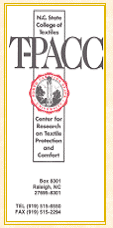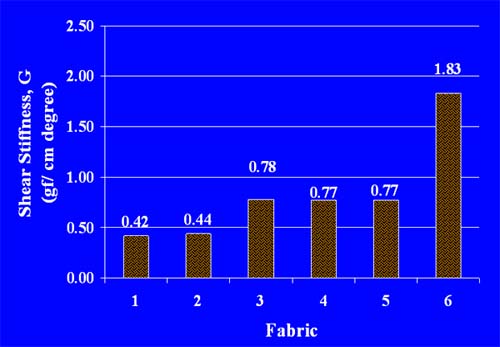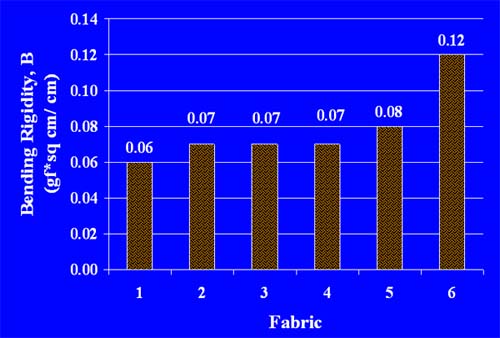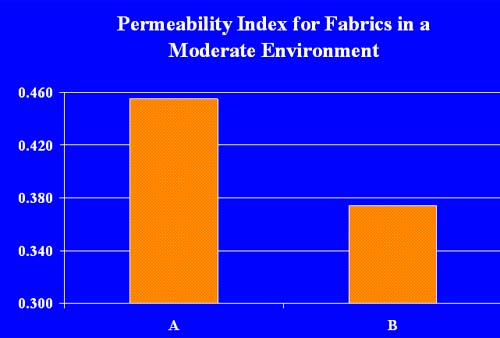 Textile
Textile
Protection
And
Comfort
Center
Hosiery Comfort Components
- Tactile Factors
- Thermophysiological
- Heat Management
- Moisture Transport
- Fit
- Sizing
- Stretch
Comfort Laboratories
- Fabric Softness
- Kawabata Evaluation System
- Human Perception evaluation of fabric hand
- Micro Climate Analysis Laboratory
- Heat & moisture transfer properties of fabrics, sweating skin models
- Moisture Transport Laboratory
- Fabric liquid absorption, wetting & wicking properties
- Clothing Comfort Laboratory
- Human wear trials in controlled climatic chamber
Tactile Properties
- Bending Rigidity (B)
- Shear Stiffness (G)
- Surface Roughness (SMD)
- Harriness Index (io)
- Contact Points (nk)
- Transient Heat (qmax)
- Wet Cling Index (lk)




Transient Heat Conduction (qmax) May Forecast Wearer Comfort
Thermalphysiological Comfort
- Sweating Guarded Hot Plate
- Dynamic Sweating Hot Plate
- Liquid Moisture (GATS)
- Thermal Manikin (Coppelius)


Human Testing Protocols
- Hand Panels
- Controlled Wear Trials
- Actual Use Wear
------ Environmental Condition -----
| Test Period | Time | Activity | Temperature Relative_Humidity) | |
|---|---|---|---|---|
| (minutes) | oC (oF) | (%) | ||
| 0 (no rating) | 15 | Preconditioning | 21 (70.0) | 65 |
| 1 | 10 | Rest | 21 (70.0) | 65 |
| 2 | 15 | Aerobic exercise* | 21 (70.0) | 65 |
| 3 | 15 | Rest | 27 (80.6) | 65 |
| 4 | 5 | dexterity activity | 27 (80.6) | 65 |
| 5 | 10 | cool down | 21 (70.0) | 65 |
*Designed to produce sweat: mild aerobic stepping exercise. Rate at end of each period.
| SensoryDescriptor | PhysicalProperty |
|---|---|
| Snug | Fit |
| Heavy | Weight |
| Stiff | Bending |
| Sticky | Moisture |
| Nonabsorbent | Moisture |
| Clammy | Moisture |
| Damp | Moisture |
| Clingy | Moisture |
| Prickly | Surface |
| Nonstretchy | Tensile |
| Scratchy | Surface |
Real Use Wear Trials
- Most Realistic Results
- Often Difficult to Recruit and Execute
- Often Requires Long Time to Execute
All-Day Screening Protocol
- Use Cross-Stretch, Size and Foot Size
- Developed Jointly with T-PACC/HTC
- Will Use CVCC Student Groups
- Will Use Validated Comfort Questionnaires
- Statistical Analysis by Extension/T-PACC
Hosiery Comfort and Fit Project
- Phase One
- Prototype Study
- Gather data on subject size
- Gather data on hosiery size
- Gather data on comfort and fit Perform statistical correlation
- Provide Industry, Testing Laboratory, Retailers Information on Sizing and Comfort
- Prototype Study
-
Phase Two
- Perform detailed human sizing research (anthropometric database)
- Perform measurement on test hosiery
- Perform laboratory sizing/stretch measurements Perform wear trials for comfort and fit
- Perform statistical analysis
- Provide industry and retailers sizing/fit guidance
Guidance of Project
- Sizing/fit consortium will lead on hosiery style selection (men’s socks, pantyhose, body stockings, etc.)
- Committee will guide on sample variables selected (size, stretch, other sample characteristics)
- Committee will review protocols and goals at each step
Project Execution
- Will use state-of-the-art body size/shape information
- Will recruit test subjects from typical user populations
- Will perform well-validated laboratory tests
- Will perform validated human test protocols
- Will use best statistical techniques
Desired Technical Results of Project
- Develop good understanding of current state of comfort and fit of hosiery
- Establish correlation between laboratory tests and sizing with comfort and fit
- Provide industry, laboratories and retailers valuable guidance on sizing and stretch
- Provide good database on population size and shape
Goals of Project
- To Create Improved Understanding of Hosiery Sizing and Fit
- To Provide Industry with Information to Give Guidance on Quality of Product
- To Provide Laboratories and Retailers an Understanding of Needed
- Size/Stretch for Meeting Customer Needs
- Reducing Off-quality and Returns
<< Previous Page >>